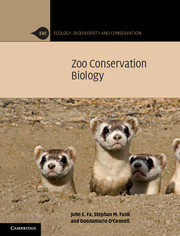Book contents
- Frontmatter
- Contents
- Foreword
- Preface
- Acknowledgements
- 1 Biodiversity and zoo conservation biology
- 2 Protecting species and habitats
- 3 Zoos in focus – public exhibition or conservation
- 4 Keeping animals in captivity
- 5 Viable captive populations – the numbers game
- 6 Captive breeding and zoos
- 7 Returning animals to the wild
- 8 Educating the public
- 9 Turning zoos into conservation centres
- Appendix 1 Commonly used abbreviations
- Appendix 2 Scientific names of species mentioned in the text
- Appendix 3 Inbreeding
- Appendix 4 Population sizes – definitions and implications
- Appendix 5 Captive breeding and genetics – definitions
- References
- Index
- Plate section
6 - Captive breeding and zoos
Published online by Cambridge University Press: 05 August 2012
- Frontmatter
- Contents
- Foreword
- Preface
- Acknowledgements
- 1 Biodiversity and zoo conservation biology
- 2 Protecting species and habitats
- 3 Zoos in focus – public exhibition or conservation
- 4 Keeping animals in captivity
- 5 Viable captive populations – the numbers game
- 6 Captive breeding and zoos
- 7 Returning animals to the wild
- 8 Educating the public
- 9 Turning zoos into conservation centres
- Appendix 1 Commonly used abbreviations
- Appendix 2 Scientific names of species mentioned in the text
- Appendix 3 Inbreeding
- Appendix 4 Population sizes – definitions and implications
- Appendix 5 Captive breeding and genetics – definitions
- References
- Index
- Plate section
Summary
‘What I had in mind was an almost completely new concept of the motivation of a zoological garden…The idea was that the captive colonies should be set up…as a safeguard against extinction, while at the same time the most stringent efforts should be made to preserve the wild habitat and wild populations of the species concerned and to release back to the wild captive-bred animals when their habitat had been made safe. This, it seemed to me, was a zoo's major raison d’être.’
(Gerald Durrell)Introduction
There is general agreement that captive breeding, the process of reproducing animals in human controlled environments in zoos or other ex-situ facilities, can save threatened species from extinction. The IUCN technical guidelines on the Management of Ex-Situ Populations for Conservation officially recognise the role that zoos, botanic gardens, aquariums, gene banks and research facilities could play in species conservation (IUCN, 1987a, 1992, 2002). This declaration of intent is believed to indicate an evolution in the strategic application of ex-situ conservation, as well as reflecting the recent developments in the science and practice associated with it (Maunder & Byers, 2005).
- Type
- Chapter
- Information
- Zoo Conservation Biology , pp. 142 - 189Publisher: Cambridge University PressPrint publication year: 2011
- 1
- Cited by



